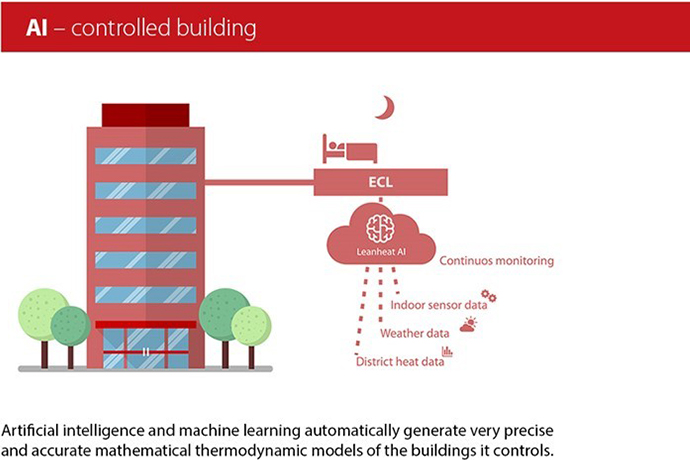
Digitalization has already transformed the way we consume and optimize energy usage but the potential is much bigger thanks to the huge amount of data that will be collected from The Internet of Things (IoT) wireless sensors and AI (Artificial Intelligence) capabilities.
It is no longer enough to have smart, stand-alone heating products. Only by connecting energy plants, buildings and homes can we build on data and leverage the new heating opportunities. Extensive use of digitalization can make the whole energy system smarter, more efficient, more environment friendly and more reliable: it enables control of temperature and flows, inter-connecting production plants, distribution network, buildings and individual homes in real-time. It uses data from sensors and energy meters in all parts of the network to analyze and predict heating demand and production in order to create a truly energy efficient system.
By 2030, cities will consume 60-80% of energy resources. In addition, cities are responsible for 70% of global emissions. In the EU 36% of all CO2 emissions come from buildings. The optimization of current technical building systems alone potentially leads to 30% savings - 67 billion euros annually. Within the building sector for energy renovation, on average 18 jobs are created per 1 million euro invested in energy efficiency renovations. Only complete decarbonization of buildings can secure EU transition to the low carbon economy by 2050.
Traditional heating systems do not meet energy efficiency goals: they fail to adjust to weather conditions, ventilation and thermodynamic properties of the building or the inhabitants’ living patterns. This results in the growth of energy consumption and power demand in the city, overheating, poor indoor climate and more emissions. Residents are facing humidity issues, building owners are facing growth of costs, energy companies struggle to meet demand and CO2 emissions increase.
The most effective solutions are enabled by the most emerging technologies, IoT sensors and AI. Smart and connected, AI powered heating solutions can deliver significant benefits, both to the building owners, district heating companies, and residents. It can help reduce energy consumption, achieve the much-needed energy savings in buildings and play a relevant/key role in achieving the Paris Agreement goal of limiting global warming to 1.5 degrees Celsius by 2030.
The fact is emphasized by Lars Tveen, President Danfoss Heating: “With 70 per cent of the world’s population living in cities by 2050, we need to reconcile the urbanization trend with climate change mitigation, and success will depend on sustainable cities with buildings that are truly energy efficient. The energy and comfort performance of buildings must be optimal under actual building use conditions and take into account peak loads and how they are covered”.
Some of the most innovative solutions for intelligent buildings and district heating companies are developed by Leanheat, Finish developer and provider of IoT heating solutions that upgrade building HVAC systems for the digital age. These are low-cost, easily applicable, advanced technologies which are enabling significant savings in energy and money.
“We make buildings smart. For us a smart building is a building that uses just the right amount of energy, is easy to maintain and has a good indoor climate for its residents. And when looking at the future, we see that intelligent buildings will play an active part in the energy system, and they will consume less energy when energy is expensive to produce”, says Jukka Aho, Founder of Leanheat.

Leanheat: 12% lower costs
Espoon Asunnot, a housing company that owns 15,000 apartments in Finland, was one of the first to start utilizing the Leanheat solution. In the first phase, the company was able to reduce the consumption of district heating by almost 10%. In the second phase, the company focused its attention on peak loads, which determine the size of the basic fee for district heating. Artificial intelligence helped reduce the peaks by 24% on average, which alone means a cost saving of approximately 12% on the heating costs of Espoon Asunnot.
Global energy company Fortum has integrated the Leanheat software into their Smart Living Solutions, which enable end-users to monitor their individual energy consumption. That has helped one housing association alone save 8% in energy consumption (this corresponds to the annual heating consumption of 630 single-family houses), and CO2 emissions reduced by 3,800 tons.
“For a long time, heating systems in buildings have relied on traditional temperature charts based on the outside temperature only. This often leads to many problems, such as over-heating”, says Real Estate Manager Teemu Jalomäki of Asuntosäätiö Asoodit, one of the largest housing owners in Finland. That's why they have started the collaboration with Leanheat. After the first winter – by controlling the district heating system with real-time measurements and AI – they have reduced the peak demand of district heating by 21% on average. Leanheat software transforms district heating company into virtual power plants that can be optimized in real time 24/7: the software can predict peak demand and adjust consumption before or after peak hours, which can bring up to 20% reduction to heating plant peak loads. That means that district heating companies can meet needs of 25% more customers with existing peak load capacity.

HOW IT WORKS: optimizing both buildings and district heating
- Leanheat solution uses artificial intelligence to control and monitor centrally heated buildings
- Data from the building’s central control room is combined with data collected from IoT sensors located in the individual apartments in the building
- AI processes the data and the central heating can be controlled in an optimal manner taking into consideration weather, ventilation and the living patterns of the inhabitants
- During a two-week teaching period after installation, Leanheat’s machine-learning software creates a unique mathematical model for each building. The model takes into account the building’s capacity to charge and discharge heating energy in different conditions
- Building owners could save 10-20% with smart heating control; district heating company can cut peak load by 20%; residents get better indoor climate and stable level of humidity



